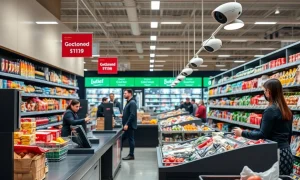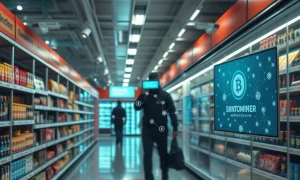Retail theft represents a significant challenge for businesses globally. Annually, it costs the industry billions of dollars. This financial drain often leads to higher prices for consumers. Consequently, retailers constantly seek innovative solutions to mitigate these losses. A major supermarket chain has recently unveiled a bold new strategy. It involves offering customer rewards for shoplifting reports. This initiative aims to empower shoppers and enhance overall store security. It signifies a proactive step in the ongoing battle against retail crime.
Understanding the Escalating Problem of Retail Theft
Shoplifting is not merely a minor nuisance. It has evolved into a sophisticated problem. Organized retail crime rings contribute significantly to this issue. These groups often target high-value items. They then resell these goods on various platforms. This organized activity creates substantial financial damage for businesses. Furthermore, individual acts of shoplifting also add up. They collectively impact a store’s profitability. Therefore, many retailers struggle to maintain inventory accuracy. They also face increased operational costs.
Traditional security measures, such as cameras and security guards, often deter some theft. However, they cannot cover every angle. Thieves adapt their methods constantly. They exploit vulnerabilities in store layouts and staffing. The sheer volume of transactions also makes comprehensive oversight difficult. Consequently, retailers must explore diverse prevention tactics. This ongoing challenge necessitates creative and community-driven approaches.
The Innovative Approach: Customer Rewards for Shoplifting Reports
This supermarket chain’s new program introduces a novel concept. It directly involves customers in theft prevention. The core idea is simple: incentivize shoppers to report suspicious activity. These incentives, or customer rewards for shoplifting reports, provide a tangible benefit. They encourage vigilance within the store environment. This strategy transforms passive observers into active participants. It shifts some responsibility from security personnel to the broader community.
The program’s design emphasizes discretion and safety. Customers are not expected to intervene directly. Instead, they report observations through established channels. This approach prioritizes customer safety above all else. It also seeks to create a deterrent effect. Potential shoplifters might reconsider their actions. They know that more eyes are watching. This collective vigilance can significantly reduce theft incidents. It fosters a shared sense of ownership over store security.
How the Program Works: Mechanics and Implementation
The implementation of this reward program is crucial for its success. The supermarket chain has established clear reporting mechanisms. Customers can typically use a dedicated mobile application. Alternatively, a discreet hotline might be available. These channels allow for anonymous or confidential submissions. Users provide details about suspicious individuals or activities. This information includes descriptions and locations within the store.
Upon receiving a report, trained security personnel verify the information. This verification process is critical. It prevents false accusations and ensures accuracy. For instance, staff might review surveillance footage. They could also dispatch plainclothes security officers. If the report leads to a confirmed theft or apprehension, the customer becomes eligible for a reward. The specific details of these customer rewards for shoplifting reports vary. They might include store credit, discounts on future purchases, or even cash incentives. Transparency in the reward system builds trust with participants.
- Anonymous reporting options protect customer privacy.
- Dedicated security teams verify all submitted claims promptly.
- Rewards are issued only after successful verification and action.
- Clear guidelines ensure proper use of the reporting system.
Benefits for Retailers and Customers
This innovative program offers multiple advantages. For retailers, the primary benefit is a reduction in financial losses. Less theft means improved profitability. It also leads to more accurate inventory management. Furthermore, the presence of an active reporting system can act as a powerful deterrent. This might reduce the need for extensive, costly security infrastructure. It also allows existing security staff to focus on more complex cases. Consequently, the overall security posture of the store strengthens considerably.
Customers also benefit significantly from this initiative. Firstly, they gain a safer and more pleasant shopping experience. Reduced theft often translates to lower prices in the long run. Moreover, participating customers receive tangible rewards. These incentives provide a direct benefit for their vigilance. The program also fosters a sense of community involvement. Shoppers feel empowered to contribute positively. This collaborative effort builds stronger relationships between the store and its patrons. Ultimately, it creates a more secure and trustworthy retail environment for everyone involved. The focus on customer rewards for shoplifting reports creates a win-win scenario.
Addressing Concerns and Ethical Considerations
Implementing such a program requires careful consideration of potential pitfalls. One major concern involves the possibility of false reports. Individuals might report others maliciously or mistakenly. Therefore, the verification process must be robust. It needs to prevent innocent shoppers from being wrongly accused. The supermarket chain must invest in thorough training for its security teams. They need to handle sensitive situations with professionalism and discretion. Protecting customer privacy is another paramount concern. The reporting system must ensure data security. It also needs to safeguard the anonymity of reporters if requested.
Furthermore, the program must avoid encouraging vigilantism. Customers should report, not confront. Clear communication about these boundaries is essential. The supermarket chain has a responsibility to educate its patrons. They must understand their role is observational, not interventionist. Maintaining a neutral, fact-based approach to investigations is vital. This ensures fairness and prevents a ‘snitch culture’ from developing. Ethical guidelines must underpin every aspect of the program. They ensure that customer rewards for shoplifting reports serve their intended purpose without negative consequences.
The Broader Impact on Retail Security
This pioneering initiative could reshape the landscape of retail security. If successful, other supermarket chains and retailers might adopt similar models. This shift would signify a broader trend. It indicates a move towards community-centric security solutions. Retailers are increasingly recognizing the value of collective vigilance. Technology also plays a crucial role in enabling such programs. Mobile apps and data analytics can streamline reporting and verification processes. Therefore, the future of retail security may involve more integrated systems. These systems combine traditional methods with public participation.
The long-term success of customer rewards for shoplifting reports depends on several factors. These include consistent implementation and transparent communication. Public acceptance is also key. This strategy represents a bold step forward. It demonstrates a commitment to innovation in crime prevention. Ultimately, it aims to create safer spaces for both shoppers and employees. This proactive stance could set a new industry standard. It offers a promising pathway to significantly reduce retail theft across the board.
This innovative program marks a significant departure from conventional security methods. It directly tackles the pervasive problem of retail theft. By leveraging community involvement, the supermarket chain aims to create a more secure shopping environment. The success of customer rewards for shoplifting reports could inspire widespread adoption across the retail sector. As businesses continue to face evolving threats, such proactive and collaborative solutions become increasingly vital. This initiative represents a forward-thinking approach to an age-old problem, promising a safer future for retail.
Frequently Asked Questions (FAQs)
What exactly are Customer Rewards for Shoplifting Reports?
Customer Rewards for Shoplifting Reports refers to a program where a supermarket chain offers incentives to customers who report suspicious activity or confirmed shoplifting incidents within their stores. The goal is to deter theft and enhance overall security by involving the community.
How do customers report shoplifters through this program?
Customers typically report through a dedicated mobile application or a confidential hotline. These channels allow them to provide details discreetly, often with options for anonymity. The system is designed to be user-friendly and secure.
What kind of rewards are offered for valid reports?
The specific rewards can vary. They often include store credit, discounts on future purchases, or gift cards. In some cases, cash incentives might also be offered. Rewards are typically issued upon successful verification of the report leading to action.
Are reports made through this program kept anonymous?
Yes, most programs of this nature offer options for anonymous reporting. This protects the privacy of the customer and encourages more people to participate without fear of reprisal. The supermarket chain prioritizes reporter confidentiality.
What are the potential downsides or ethical concerns of such a program?
Potential downsides include the risk of false reports, privacy concerns for individuals reported, and the need to prevent vigilantism. The program requires robust verification processes, strict ethical guidelines, and clear communication to mitigate these risks and ensure fairness.
Will this program be adopted by more supermarkets and retailers?
If this pilot program proves successful in significantly reducing retail theft and maintaining positive customer relations, it is highly probable that other supermarket chains and retailers will consider adopting similar models. It represents a new, community-driven approach to security.






